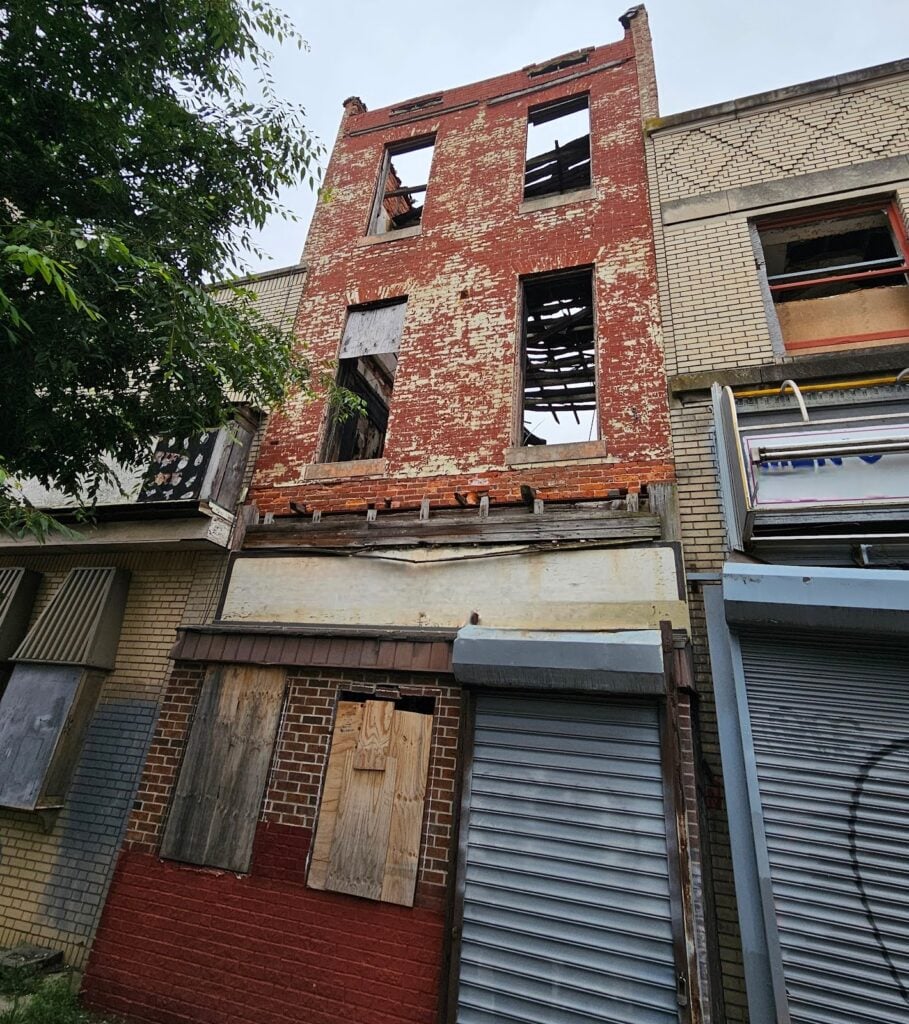Causes of collapsing roofs in ruined buildings
Here in Washington, DC, as property values increase as the city improves, overall, there are fewer and fewer dilapidated buildings. Years ago though, it was different. Many buildings, after facing volatile economic cycles, were left abandoned, in dereliction and poor condition. As the buildings deteriorated significantly, without a strong and intact building envelope, the remainder of the building falls apart very quickly. Here, the building facade is built with a historic brick masonry, like many of the buildings here in Washington, DC.
That particular brick and masonry assembly is strong and can withstand decades of age and deterioration without significant failure. The other areas of the building, particularly the roof and the windows which are other key ingredients of the building envelope, became significantly deteriorated, to the point that they were basically collapsed, destroyed, or missing from the building facade.

We always realize and mention, here on our blog, that we can learn so much about the science of building construction, particularly as it applies to historic buildings, of the type built here in Washington, DC, by looking at the ruins and destroyed elements of buildings. These types of partially or fully destroyed buildings give us a cutaway type view which shows us things that we don’t normally get to see in completed buildings. It’s also not the same as looking at a new building.
New buildings are simply built with different materials and in different types of ways with modern building assemblies. Historic buildings were built differently, but it still matters. It matters because even though one building might be destroyed, both because of its age, but even more importantly because of lack of care, upkeep, maintenance and stewardship, many others, even thousands, remain in serviceable working condition here in Washington, DC. Unlike modern construction techniques, there is not as much information available on historic building methodologies from the time when these Washington DC historic buildings were created.
One of the reasons that there’s not a lot of information available is because they weren’t built in the same way throughout the remainder of the United States, so they are somewhat unique. In fact, at the time of the construction of many of these buildings here in Washington DC, the population of the United States was still relatively small. There weren’t that many buildings in other parts of the country and in the massive expansion of the population of the United States, the amount of buildings that were built in the many decades after the original construction of these buildings was significant.
As you look through the original window openings of the building facade, you can see right up to the underside of the original top floor ceiling. This is not the same as the roof itself. The roof has a different type of framing than the top floor ceiling. People often confuse ceilings with roofs. They’re not the same thing, but sometimes, in typical American vernacular people will call a ceiling a roof or vice versa which doesn’t actually make sense. Ceilings are interior finishes. Roofs are exterior finishes that create an upper portion of the envelope of the building assembly.

One of the reasons that you can instantly tell that this is not the framing of the roof itself is that it’s installed lower than the roof framing. The roof and the top floor ceiling are only a few feet apart in most typical historic rowhome constructions, here in Washington, DC. Often that small space will be filled with a crawl space or attic. People often call that small attic space a crawl space because like a typical crawl space at the foundation of a home, you can’t necessarily walk through the entirety of it while standing up.
In some cases you can’t even fit through it if you crawl because it gets so tight, generally at the rear of the building that there’s only a few inches of clear space. People can’t fit in spaces that tight. In fact below certain heights or clearances it’s not always a good idea to try to squeeze to fit your body into those small areas. Sometimes you can’t always squeeze your way out of the same space as you can squeeze your way into especially while turned around, moving in reverse on the attempt to get out.
We can Help
Our company focuses on historic restoration more than modern building upkeep, maintenance, and construction, but our company understands both types of construction very well and a full picture well-rounded approach is needed in any niche in the construction industry. Although we focus on historic restoration, repointing, tuckpointing and historic brick repair, our company also has technical knowledge and competencies in the areas of modern and contemporary construction as well as we become one of the leaders in that area of the market today.
Understanding both historic and modern or contemporary construction is useful because both aspects help understand the challenges and potential solutions for challenges in building science and construction.
We can help with a variety of historic masonry restoration needs and upkeep, from modest tuckpointing and or repointing to complicated and extensive historic masonry restoration. Infinity Design Solutions is a historic restoration specialist contractor specializing in both historic masonry restoration such as tuckpointing our repointing, and brick repair.
If you have questions about the architectural details or facade of your historic building in Washington DC, reach out and say hello and if we can help we’ll be glad to assist you. You can email us or call us on the telephone at the following link: contact us here.
